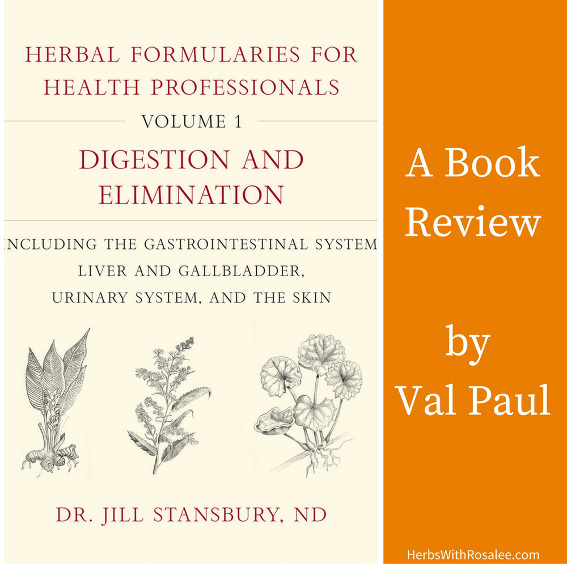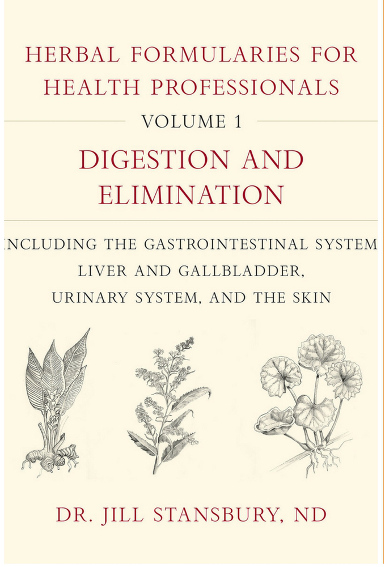Get weekly tips, recipes, and my Herbal Jumpstart e-course! Sign up for free today.

Herbal Formularies for Health Professionals Book Review
Share this! |
|
Herbal Formularies for Health Professionals, Volume 1: Digestion and Elimination by Dr. Jill Stansbury, ND
A book review by Val Paul
In writing Herbal Formularies for Health Professionals, Volume 1: Digestion and Elimination, Dr Jill Stansbury set out to create a user-friendly book on herbal formulation for the student herbalist that is also an easy-to-use reference for practitioners. To say that Dr. Stansbury did just that would be an understatement! This formulary is a standout with its emphasis on Western herbs that includes information sourced from folk usage, the Eclectic tradition, and modern scientific research all combined with 30 years of clinical experience. The beautiful illustrations throughout were also drawn by Stansbury. In this review, I will highlight some of what makes this book so special.
The Art of Herbal Formulation
The basic principles of herbal formulation are introduced in the first chapter. Dr Stansbury shares her philosophy on formulating for the presentation seen in the person instead of the diagnosis they may have. There are many excellent examples of questions to ask and energetics to consider to gather information that will enable you to create the most helpful herbal formula. The importance of symptoms, the healing crisis, and symptom suppression are also addressed.
We are then introduced to the three components—base, synergist, and specific—for building an herbal formula via an exercise that uses a triangle for a visual. How to choose herbs for each component is explained and examples are given based on different presentations. There are also case studies that show different conditions with varying patterns in each and the process of choosing herbs for those unique presentations. The chapter closes with sharing the different types of herbal medicines, on choosing the form that is best suited, and an overview of dosages for each. This approach to formulation teaches and empowers the herbalist to build their own formulas.
Digestion and Elimination, by Body System
The main part of the book is organized by body systems associated with digestion and elimination. Each system—gastrointestinal and biliary, liver and gallbladder, renal and urinary, and dermatologic— is covered comprehensively in its own chapter. The chapters include an overview of appropriate herbs to use, herbs that aren’t appropriate (when applicable), actions of those herbs, hundreds of formulas for conditions (including their different presentations), with explanatory information and dosage. There are also side bars and lists with other helpful information for food, nutraceuticals, herb spotlights, and constituents. At the end of each chapter is a materia medica that includes the herbs covered and specific indications.
A small sampling of some of the information covered in each chapter:
Gastrointestinal and Biliary System
Herbal actions: demulcents, antispasmodics, alteratives, digestive stimulants…
Conditions: dyspepsia, IBS, GERD, anorexia, ulcers, pancreatitis, diarrhea, malabsorption, leaky gut…
Materia medica: more than 70 herbs.
Liver and Gallbladder System
Herbal actions: alteratives, cholagogues, biliary antispasmodics, liver antimicrobials and liver antifibrotics.
Conditions: hepatitis, cirrhosis, liver cancer…
Materia medica: more than 40 herbs.
Renal and Urinary System
Herbal actions: five types of diuretics, the difference between hydrogogues and depurants…
Conditions: cystitis, pyelonephritis, neurogenic bladder, urinary tract irritability, overactive bladder, bladder and prostate cancers, prostate disease…
Materia Medica: more than 80 herbs.
Dermatologic System
Herbal actions: alteratives, antiallergy, vulnerarys…
Conditions: trauma (e.g. stings, burns), infections, wound healing, childhood skin eruptions, dermatitis, hives, scabies and lice, warts, acne, rosacea, lichen planus, alopecia and hirsutism, pigmentation disorders, skin ulcer, cellulite, fissures…
Materia medica: more than 100 herbs.
The formulas throughout the book include a variety of herbal preparations, such as teas, decoctions, tinctures, infused vinegars, herbal milk, candy, smoothies, truffles, sitz baths, suppositories, heat packs, spray, creams, oils…In addition to Dr Stansbury’s own formulas, there a few well-known formulas from various herbal traditions.
In Closing
Herbal Formularies for Health Professionals, Volume 1: Digestion and Elimination is a must-have for anyone passionate about the practice of herbal medicine. It is full of knowledge, written in a clear manner by an experienced and talented practitioner. I have no doubt that this book will become a classic and part of the curriculum at many herbal schools.
I am also delighted that this is just the first in a series that will cover other body systems. The upcoming books in the series are:
Volume II (Circulation and Respiration), available in July 2018
Volume III (Endocrinology), available in autumn 2018
Volumes IV (Neurology, Psychiatry, and Pain Management) and V (Immunology, Orthopedics, and Otolaryngology), available in spring 2019.
Herbal Formularies for Health Professionals, Volume 1: Digestion and Elimination can be found at Chelsea Green Publishing or Amazon.
Dr. Stansbury can be found at her practice Battle Ground Healing Arts.
Herbal Formularies for Health Professionals, Volume 1: Digestion and Elimination
Pages: 352 pages
Book Art: Black-and-white illustrations throughout
Size: 8 x 10 inch
Publisher: Chelsea Green Publishing
Pub. Date: March 26, 2018
ISBN: 9781603587075

Rosalee is an herbalist and author of the bestselling book Alchemy of Herbs: Transform Everyday Ingredients Into Foods & Remedies That Healand co-author of the bestselling book Wild Remedies: How to Forage Healing Foods and Craft Your Own Herbal Medicine. She's a registered herbalist with the American Herbalist Guild and has taught thousands of students through her online courses. Read about how Rosalee went from having a terminal illness to being a bestselling author in her full story here.

